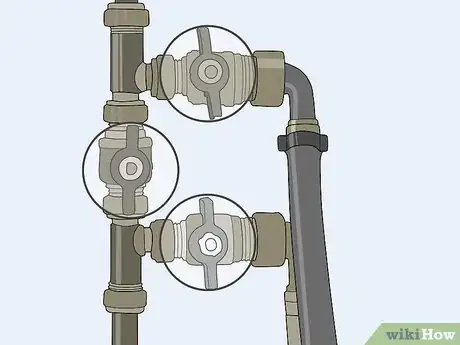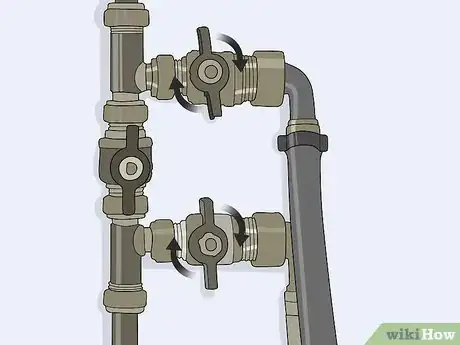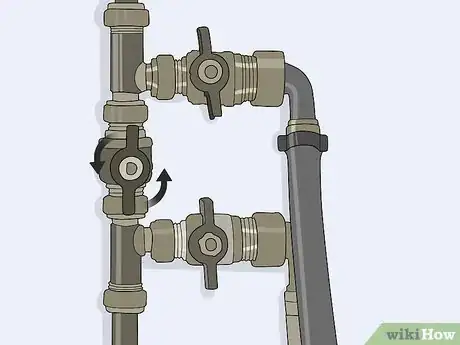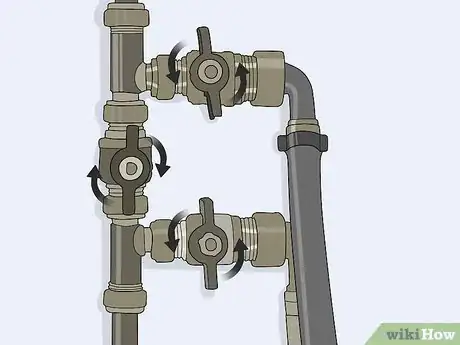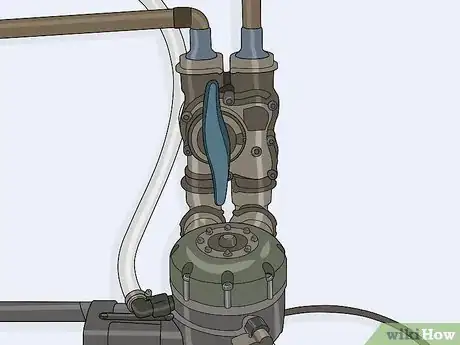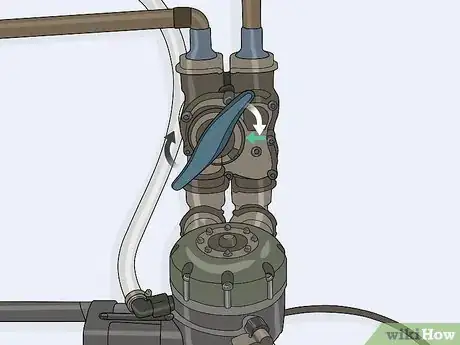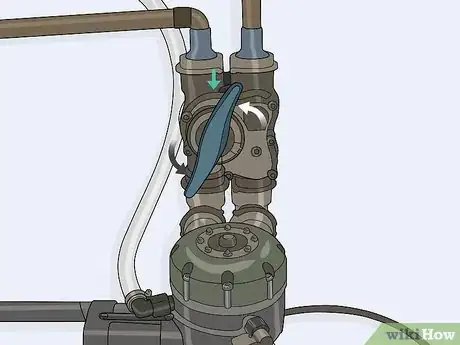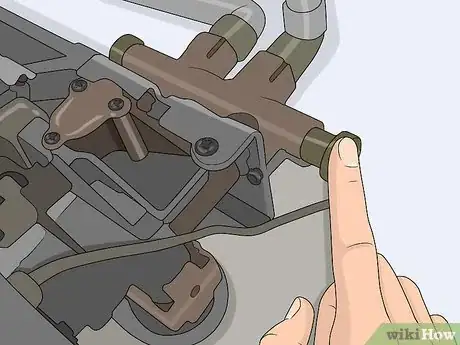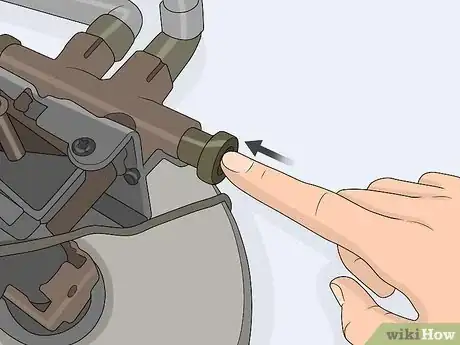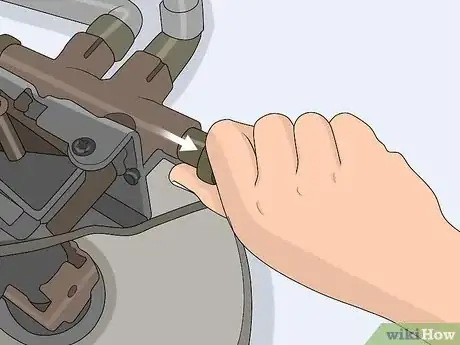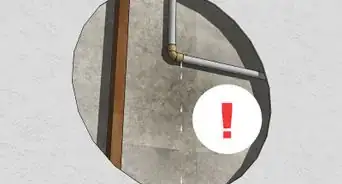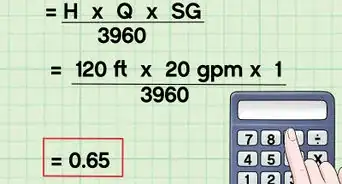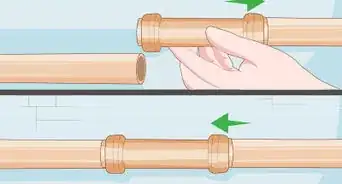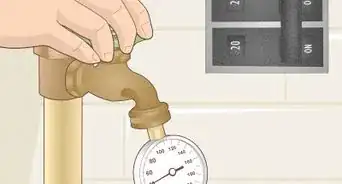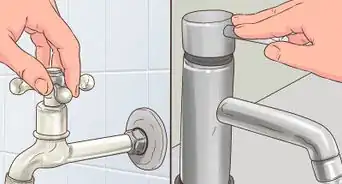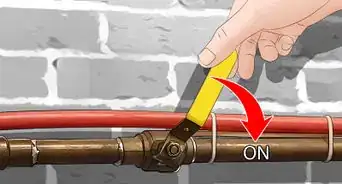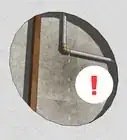This article was co-authored by wikiHow Staff. Our trained team of editors and researchers validate articles for accuracy and comprehensiveness. wikiHow's Content Management Team carefully monitors the work from our editorial staff to ensure that each article is backed by trusted research and meets our high quality standards.
This article has been viewed 30,368 times.
Learn more...
When you want to bypass a water softener temporarily to perform maintenance, it’s a simple matter of locating the bypass valve for the softener and setting it to stop directing water through the softener. However, there are several different types of bypass valves, so it’s important to understand what each kind looks like and how to set it to bypass correctly. You’ll also need to know how to return the water softener to service when you want to start directing water through it again.
Steps
Using a 3-Valve Bypass
-
1Find the valves by following the 2 large hoses running out of the water softener. Locate the water softener, then look for 2 large hoses running out of it, normally either out of the side or the back. These are the inlet and outlet hoses for water moving through the softener. Follow them to lead you to the bypass valve.[1]
- Keep in mind that the bypass valve may be on the other side of a wall or in a cupboard, but if you keep following the hoses they will eventually lead you to it.
- If you don’t know where the water softener is located, check near the water supply inlet for the building. This might be in the basement or garage and is usually near the water heater.
Tip: Depending on what type of water softener you have, there might be some other smaller hoses and cables running off of it. However, you need to find the 2 largest hoses. They might be made of flexible plastic or braided metal.
-
2Close the inlet and outlet valves connected to the 2 hoses. The inlet and outlet valves are the 2 plastic knobs located where the 2 hoses connect to the rest of the piping. Turn them 90 degrees so they are perpendicular to the hoses in order to close them.[2]
- The knobs have something like wings on the sides that will show you which way they are turned. When the wings are running across the piping they are closed and when they are running in line with the piping they are open.
Advertisement -
3Open the bypass valve by turning it so the handle is in line with the pipe. The bypass valve is the third valve located between the inlet and outlet valves on the main pipe. Turn it 90 degrees so the wings run parallel to the main pipe to open it and start bypassing the water softener.[3]
- The water system is now just running the normal water service without sending anything to the water softener.
-
4Return the valves to the original positions when you want soft water again. Close the bypass valve by turning it so the wings of the knob are perpendicular to the pipe. Open the inlet and outlet valves by turning them so the wings run parallel to the hoses.[4]
- The water system is now sending water through the water softener again.
Operating a Single-Valve Lever-Type Bypass
-
1Locate the bypass valve near the tubes running off the water softener. Look for a lever-like valve near the inlet and outlet tubes of the water softener. There will usually be 2 labels that say “bypass” and “service,” or something similar, as well as an arrow showing which setting it is on.[5]
- If you don’t see a printed arrow that indicates which setting the lever handle is on, then look for a small metal point on the side that lines up with either “bypass” or “service.”
- Water softeners are usually located near the water supply inlet. This could be in the basement or garage of the building and is typically near where the water heater is located.
Tip: Some single-valve bypasses consist of a plastic knob instead of a lever-type handle. They will still have arrows or labeled instructions indicating which way you need to turn it.
-
2Turn the valve to the “bypass” position to shut off soft water service. Rotate the lever handle 90 degrees until the arrow indicates that it is set to bypass. Make sure it is turned all the way to bypass so you know that the softener service is completely turned off.[6]
- The inlet and outlet valves for the water softener will now be shut and water will not be directed through the water softener.
-
3Return the valve to the “service” position to start softening water again. Turn the lever handle back 90 degrees in the direction you originally turned it from until the arrow indicates that soft water service is on again. Double-check that it is turned as far as it can go in that direction to ensure service is fully on.[7]
- This will open the inlet and outlet valves again and redirect water through the water softener.
Bypassing with a Push-Type Valve
-
1Look for the push-knob near the tubes running off the softener. Find the 2 large inlet and outlet tubes at the back or on the side of the water softener. Locate a push knob labeled with “bypass” or “on/off.”[8]
- There are 2 main types of push valves. The first type is called a “push-push” valve and functions by pushing it in from 1 side and then pushing it back out from the other side. The second type is a “push-pull” valve and functions by pushing it in from 1 side and pulling it back out from the same side.
- If you aren’t sure where the water softener is located, check near the water heater. Water softeners are usually installed near the water supply inlet for the building, which is often in a basement or garage.
Tip: Some push-push-type valves have colored knobs indicating which setting it is on. Typically, if the blue or green knob is pushed in it means the service is on, and if the red or black knob is pushed in it means the service is off.
-
2Push the knob in to bypass the water softener service. Push on the end of the knob slowly until it is fully inserted and you can’t push it any more. There will be arrows and labels indicating which setting it is on.[9]
- If you have a push-push valve, you will see a knob move out on the other side as you push the knob in from 1 side.
-
3Pull the knob out or push it in from the other side to turn the service back on. Push the knob in from the other side if you have a push-push valve. Pull the knob back out if you have a push-pull valve.[10]
- Double-check the labels to ensure that the push-knob is in the “on” or “service” position.
References
- ↑ https://www.youtube.com/watch?v=Xpx4zu0aZLw&feature=youtu.be&t=46
- ↑ https://www.youtube.com/watch?v=Xpx4zu0aZLw&feature=youtu.be&t=100
- ↑ https://www.youtube.com/watch?v=Xpx4zu0aZLw&feature=youtu.be&t=103
- ↑ https://products.geappliances.com/appliance/gea-support-search-content?contentId=21674
- ↑ https://inspectapedia.com/plumbing/Water_Softener_Bypass.php
- ↑ https://inspectapedia.com/plumbing/Water_Softener_Bypass.php
- ↑ https://inspectapedia.com/plumbing/Water_Softener_Bypass.php
- ↑ https://inspectapedia.com/plumbing/Water_Softener_Bypass.php
- ↑ https://inspectapedia.com/plumbing/Water_Softener_Bypass.php
